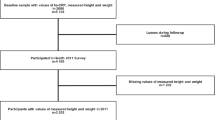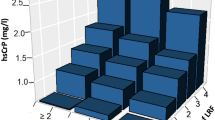Abstract
There is evidence to show an association between inflammation, obesity and elevated blood pressure. However, there is limited data for this relationship in adolescent females. We aimed to investigate the association between high sensitivity C-reactive protein (hs-CRP) and elevated blood pressure in young Australian females. Women aged 16–25 years living in Victoria were randomly recruited via targeted Facebook advertising. Socio-demographic information was collected via a web-based questionnaire. Anthropometric and blood pressure measurements were conducted by trained staff. Hs-CRP was assessed using the Abbott Architect assay. The demographic data were collected from 639 females (mean ±s.d. age: 22±3). The blood pressure data were available for 502 participants. Approximately 28% had elevated blood pressure (defined by a blood pressure reading ⩾120–139/80–89 mm Hg for adults and >90th and <95th percentiles for age, sex and height for adolescents). Approximately 24% had hs-CRP >3.0 mg l−1 and 30% were overweight or obese. In multivariable logistic regression analyses, obese females (OR: 5.5, 95% CI: 2.4−12.5, P<0.001) were more likely to have elevated blood pressure compared with those with a body mass index (BMI) in the normal range. Elevated hs-CRP levels were associated with an increased odds of elevated blood pressure (OR: 3.4, 95% CI: 1.8−6.3, P<0.001). However, this association was no longer significant after adjustment for BMI. Findings from this study demonstrate that hs-CRP and obesity are associated with elevated blood pressure in young females. Thus, our findings may promote further research into the underlying mechanisms of these associations and related long-term health risks.
This is a preview of subscription content, access via your institution
Access options
Subscribe to this journal
Receive 12 digital issues and online access to articles
$119.00 per year
only $9.92 per issue
Buy this article
- Purchase on Springer Link
- Instant access to full article PDF
Prices may be subject to local taxes which are calculated during checkout
Similar content being viewed by others
References
Muntner P, He J, Cutler JA, Wildman RP, Whelton PK . Trends in blood pressure among children and adolescents. JAMA 2004; 291 (17): 2107–2113.
McNiece KL, Poffenbarger TS, Turner JL, Franco KD, Sorof JM, Portman RJ . Prevalence of hypertension and pre-hypertension among adolescents. J Pediatr 2007; 150 6: 640–644 644 e641.
Acosta AA, Samuels JA, Portman RJ, Redwine KM . Prevalence of persistent prehypertension in adolescents. J Pediatr 2012; 160 (5): 757–761.
Redwine KM, Falkner B . Progression of prehypertension to hypertension in adolescents. Curr Hypertens Rep 2012; 14 (6): 619–625.
Chobanian AV, Bakris GL, Black HR, Cushman WC, Green LA, Izzo JL et al. The Seventh Report of the Joint National Committee on Prevention, Detection, Evaluation, and Treatment of High Blood Pressure: the JNC 7 report. JAMA 2003; 289 (19): 2560–2572.
Redwine KM, Daniels SR . Prehypertension in adolescents: risk and progression. J Clin Hypertens 2012; 14 (6): 360–364.
Harrison DG, Guzik TJ, Lob HE, Madhur MS, Marvar PJ, Thabet SR et al. Inflammation, immunity, and hypertension. Hypertension 2011; 57 (2): 132–140.
Shafi Dar M, Pandith AA, Sameer AS, Sultan M, Yousuf A, Mudassar S . hs-CRP: A potential marker for hypertension in Kashmiri population. Indian J Clin Biochem 2010; 25 (2): 208–212.
Brasier AR, Recinos A 3rd, Eledrisi MS . Vascular inflammation and the renin-angiotensin system. Arterioscler Thromb Vasc Biol 2002; 22 (8): 1257–1266.
Hage FG . C-reactive protein and hypertension. J Hum Hypertens 2014; 28 (7): 410–415.
Sesso HD, Buring JE, Rifai N, Blake GJ, Gaziano JM, Ridker PM . C-reactive protein and the risk of developing hypertension. JAMA 2003; 290 (22): 2945–2951.
Bermudez EA, Rifai N, Buring J, Manson JE, Ridker PM . Interrelationships among circulating interleukin-6, C-reactive protein, and traditional cardiovascular risk factors in women. Arterioscler Thromb Vasc Biol 2002; 22 (10): 1668–1673.
Bautista LE, Lopez-Jaramillo P, Vera LM, Casas JP, Otero AP, Guaracao AI . Is C-reactive protein an independent risk factor for essential hypertension? J Hypertens 2001; 19 (5): 857–861.
Wakabayashi I . Stronger associations of obesity with prehypertension and hypertension in young women than in young men. J Hypertens 2012; 30: 1423–1429.
Fenner Y, Garland SM, Moore EE, Jayasinghe Y, Fletcher A, Tabrizi SN et al. Web-based recruiting for health research using a social networking site: an exploratory study. J Med Internet Res 2012; 14 (1): e20.
Callegari ET, Reavley N, Garland SM, Gorelik A, Wark JD . Vitamin D status, bone mineral density and mental health in young Australian women: the Safe-D study. J Public Health Res 2015; 4: 594.
National Health and Medical Research Council, Australian Research Council, Australian Vice-Chancellors' Committee. National Statement on Ethical Conduct in Human Research (2007) (Updated May 2015). National Health and Medical Research Council: Canberra, Australia, 2015. https://www.nhmrc.gov.au/_files_nhmrc/publications/attachments/e72_national_statement_may_2015_150514_a.pdf.
Redwine KM, Acosta AA, Poffenbarger T, Portman RJ, Samuels J . Development of hypertension in adolescents with pre-hypertension. J Pediatr 2012; 160 (1): 98–103.
Li JJ . Inflammation in hypertension: primary evidence. Chin Med J 2006; 119 (14): 1215–1221.
Aronson D, Bartha P, Zinder O, Kerner A, Markiewicz W, Avizohar O et al. Obesity is the major determinant of elevated C-reactive protein in subjects with the metabolic syndrome. Int J Obes Relat Metab Disord 2004; 28 (5): 674–679.
Wilson PW, D'Agostino RB, Sullivan L, Parise H, Kannel WB . Overweight and obesity as determinants of cardiovascular risk: the Framingham experience. Arch Intern Med 2002; 162 (16): 1867–1872.
Salehi-Abargouei A, Maghsoudi Z, Shirani F, Azadbakht L . Effects of dietary approaches to stop hypertension (DASH)-style diet on fatal or nonfatal cardiovascular diseases—incidence: a systematic review and meta-analysis on observational prospective studies. Nutrition 2013; 29 (4): 611–618.
Sacks FM, Svetkey LP, Vollmer WM, Appel LJ, Bray GA, Harsha D et al. Effects on blood pressure of reduced dietary sodium and the dietary approaches to stop hypertension (DASH) diet. DASH-sodium collaborative research group. N Engl J Med 2001; 344 (1): 3–10.
Australian Institute of Health and Welfare. Women and heart disease: cardiovascular profile of women in Australia. Cardiovasc Dis Series 2010; 33: 48–50.
Sheppard JP, Fletcher B, Gill P, Martin U, Roberts N, McManus RJ . Predictors of the home-clinic blood pressure difference: a systematic review and meta-analysis. Am J Hypertens 2015; 29 (5): 614–625.
Acknowledgements
We thank Melbourne Health Pathology and Ashwini Kale for collecting visceral data from participants. We also thank the research nurses, students and other staff who helped collect the data for the YFHI and Safe-D studies, and also the participants, without whom the studies would not have been possible. This work was supported by grants from the National Health and Medical Research Council (Program Grant #568971 and Project Grant #APP1049065).
Author information
Authors and Affiliations
Consortia
Corresponding author
Ethics declarations
Competing interests
The authors declare no conflict of interest.
Rights and permissions
About this article
Cite this article
Subasinghe, A., Wark, J., Gorelik, A. et al. The association between inflammation, obesity and elevated blood pressure in 16–25-year-old females. J Hum Hypertens 31, 580–584 (2017). https://doi.org/10.1038/jhh.2017.33
Received:
Revised:
Accepted:
Published:
Issue Date:
DOI: https://doi.org/10.1038/jhh.2017.33



